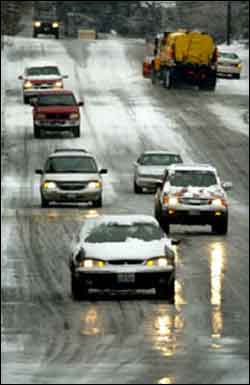Roadways and Parking Lots Threaten Freshwater Quality in the Northeastern U.S.

There are 2.6 million miles of paved roads in the United States, and new roads are being constructed daily. When parking lots and driveways are factored in, there is already enough blacktopped surface in the U.S. to cover the entire state of Ohio. Paved roads and parking spaces come in handy for our nation’s drivers, but they also come with a serious unforeseen cost— the degradation of our nation’s freshwater ecosystems.
In a recent Proceedings of the National Academy of Sciences paper, Drs. Sujay S. Kaushal, Peter M. Groffman, and Gene E. Likens of the Institute of Ecosystem Studies, with colleagues, detail how roadways and deicers are compromising the health of northeastern waters, making them inhospitable to wildlife and compromising drinking water supplies. Their insights were made possible by long-term data recorded by the Institute of Ecosystem Studies, the Hubbard Brook Ecosystem Study, the Baltimore Ecosystem Study, the U.S. Geological Survey, and the City of Baltimore.
By looking at records of chloride concentration in a range of northeastern waterways— from urban and suburban sources in New York’s Hudson Valley and Baltimore County, Maryland to rural streams in the White Mountains of New Hampshire— the researchers concluded that freshwater salinity has been increasing at an alarming rate over the past 30 years. In the Baltimore study area, there was a strong relationship between impervious surface coverage (i.e. roads and parking lots) and chloride concentration. Road salt was cited as an important source of chloride pollution.
Dr. Kaushal, a Post Doctoral Associate at the Institute of Ecosystem Studies when the research was conducted, comments, “There is a direct connection between the construction of new roadways and parking lots and the quality of our fresh water. In particular, we haven’t paid attention to how rapid changes in human development and deicer use impact the watersheds that supply our region’s drinking water.” Adding that, “We are hardening the watershed and feeding it a high sodium diet that is detrimental to the health of aquatic ecosystems.”
The changes observed were not subtle. By accumulating in ground water and aquifers, road salt was linked to year-round increases in freshwater salinity. In New York and Maryland, freshwater salinity reached levels equivalent to 25% of the concentration of seawater. In developed areas of Baltimore, chloride concentrations were already high enough to induce mortality in aquatic animals and alter wetland plant composition. Even in rural New Hampshire, where road density is low, a number of streams were as saline as the tidal waters of the Hudson River estuary.
Dr. Groffman, of the Institute of Ecosystem Studies, notes, “It is surprising and significant that the long-term record shows that salinity concentrations are going up, even in places where the amount of salt applied has not increased. Concentrations are high in the summer, not just in the winter when salt is applied to melt snow, suggesting that salt is accumulating in the environment. The salinity increases we observed in rural areas, with minimal road coverage, indicate that the urban/suburban effect on stream chloride is prevalent over large land areas.”
If salinity levels continue to rise in the northeastern U.S., Kaushal and colleagues warn that within the next century many freshwater sources will be toxic to aquatic life and unfit for human consumption. Reversing the problem involves reducing the creation of new roads and subsequent use of deicers. Despite being a major aquatic pollutant, road salt is not currently regulated as a freshwater contaminant.
Media Contact
More Information:
http://www.ecostudies.orgAll latest news from the category: Ecology, The Environment and Conservation
This complex theme deals primarily with interactions between organisms and the environmental factors that impact them, but to a greater extent between individual inanimate environmental factors.
innovations-report offers informative reports and articles on topics such as climate protection, landscape conservation, ecological systems, wildlife and nature parks and ecosystem efficiency and balance.
Newest articles

Silicon Carbide Innovation Alliance to drive industrial-scale semiconductor work
Known for its ability to withstand extreme environments and high voltages, silicon carbide (SiC) is a semiconducting material made up of silicon and carbon atoms arranged into crystals that is…

New SPECT/CT technique shows impressive biomarker identification
…offers increased access for prostate cancer patients. A novel SPECT/CT acquisition method can accurately detect radiopharmaceutical biodistribution in a convenient manner for prostate cancer patients, opening the door for more…

How 3D printers can give robots a soft touch
Soft skin coverings and touch sensors have emerged as a promising feature for robots that are both safer and more intuitive for human interaction, but they are expensive and difficult…





















